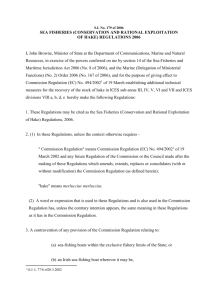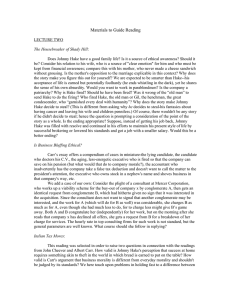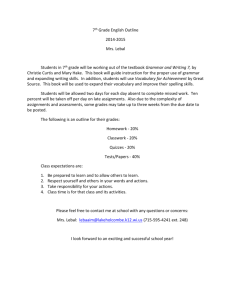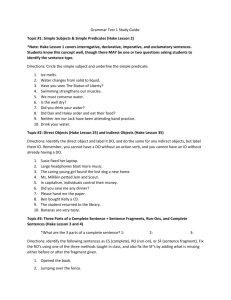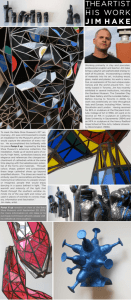Six Lessons From The Physics Education Reform Effort *†
advertisement
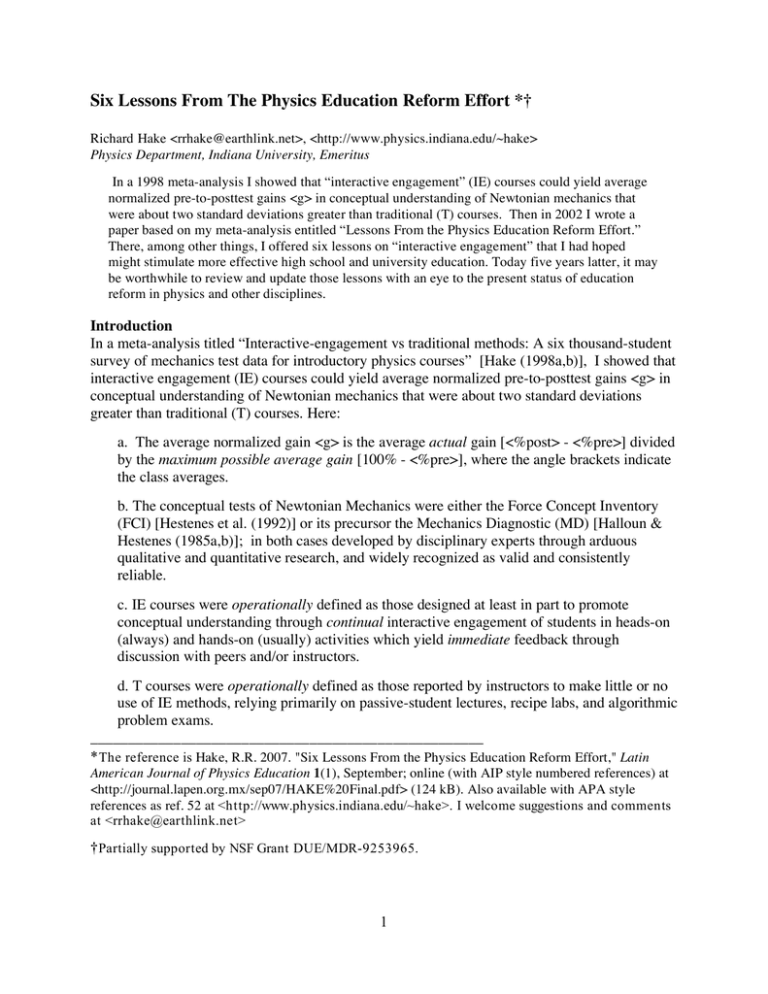
Six Lessons From The Physics Education Reform Effort *† Richard Hake <rrhake@earthlink.net>, <http://www.physics.indiana.edu/~hake> Physics Department, Indiana University, Emeritus In a 1998 meta-analysis I showed that “interactive engagement” (IE) courses could yield average normalized pre-to-posttest gains <g> in conceptual understanding of Newtonian mechanics that were about two standard deviations greater than traditional (T) courses. Then in 2002 I wrote a paper based on my meta-analysis entitled “Lessons From the Physics Education Reform Effort.” There, among other things, I offered six lessons on “interactive engagement” that I had hoped might stimulate more effective high school and university education. Today five years latter, it may be worthwhile to review and update those lessons with an eye to the present status of education reform in physics and other disciplines. Introduction In a meta-analysis titled “Interactive-engagement vs traditional methods: A six thousand-student survey of mechanics test data for introductory physics courses” [Hake (1998a,b)], I showed that interactive engagement (IE) courses could yield average normalized pre-to-posttest gains <g> in conceptual understanding of Newtonian mechanics that were about two standard deviations greater than traditional (T) courses. Here: a. The average normalized gain <g> is the average actual gain [<%post> - <%pre>] divided by the maximum possible average gain [100% - <%pre>], where the angle brackets indicate the class averages. b. The conceptual tests of Newtonian Mechanics were either the Force Concept Inventory (FCI) [Hestenes et al. (1992)] or its precursor the Mechanics Diagnostic (MD) [Halloun & Hestenes (1985a,b)]; in both cases developed by disciplinary experts through arduous qualitative and quantitative research, and widely recognized as valid and consistently reliable. c. IE courses were operationally defined as those designed at least in part to promote conceptual understanding through continual interactive engagement of students in heads-on (always) and hands-on (usually) activities which yield immediate feedback through discussion with peers and/or instructors. d. T courses were operationally defined as those reported by instructors to make little or no use of IE methods, relying primarily on passive-student lectures, recipe labs, and algorithmic problem exams. ____________________________________________________ * The reference is Hake, R.R. 2007. "Six Lessons From the Physics Education Reform Effort," Latin American Journal of Physics Education 1(1), September; online (with AIP style numbered references) at <http://journal.lapen.org.mx/sep07/HAKE%20Final.pdf> (124 kB). Also available with APA style references as ref. 52 at <http://www.physics.indiana.edu/~hake>. I welcome suggestions and comments at <rrhake@earthlink.net> † Partially supported by NSF Grant DUE/MDR-9253965. 1 In a later paper “Lessons from the physics education reform effort” [Hake (2002a)] I offered fourteen lessons, six on interactive engagement and eight on implementation, that I hoped might stimulate more effective high-school and university education. Today, five years latter, it may be worthwhile to review, update, and add to those lessons with an eye to the present status of education reform in physics and other disciplines. In the present paper I shall discuss only the six lessons on interactive engagement. These lessons are derived from my own interpretation of the physics education reform movement as it has developed over the past few decades, and are, therefore, somewhat subjective and incomplete. They are meant to stimulate discussion rather than present any definitive final analysis. LESSON 1: The use of Interactive Engagement (IE) strategies can increase the effectiveness of conceptually difficult courses well beyond that obtained by traditional (T) methods. Education research in chemistry [Krause et al. (2004)]; engineering [Froyd et al. (2006), Evans et al. (2003)]; and introductory science education generally [Handelsman et al. (2004)], although neither as extensive nor as systematic as that in physics [McDermott and Redish (1999); Redish (1999); Thacker (2003); Heron & Meltzer (2005); Hake (1998a,b; 2002a,b; 2005a; 2006a,b; 2007a,b); Wieman & Perkins (2005); Wieman (2005)] is consistent with the latter in suggesting that, in conceptually difficult areas, Interactive Engagement (IE) methods are more effective than traditional T passive-student methods in enhancing students' understanding. Furthermore, there is some preliminary evidence that learning in IE physics courses is substantially retained 1 to 3 years after the courses have ended [Chabay (1997), Francis et al. (1998), Bernhard (2001)]. I see no reason to doubt that enhanced understanding and retention would result from greater use of IE methods in other science, and even non-science, areas, but substantive research on this issue is sorely needed – see e.g., “The Physics Education Reform Effort: A Possible Model for Higher Education?” [Hake (2005a)]. Pre/post testing in biology [Klymkowsky et al. (2003), Klymkowsky (2007)]; and mathematics [Epstein (2005)] is just getting started; while pre/post test results in astronomy (Brogt et al. (2007) and geoscience [Libarkin & Anderson (2005)], have not, at this early stage, shown clearcut correlations between pre-to-posttest gain and pedagogical method, as has been shown in physics. 2 LESSON 2: The use of IE and/or high-tech methods, by themselves, does not ensure superior student learning. The data shown in Fig. 1 of “Interactive-engagement vs traditional methods: A six thousandstudent survey of mechanics test data for introductory physics courses” [Hake (1998a)], indicate that seven of the IE courses (717 students) achieved <g>'s close to those of the T courses. Five of those made extensive use of high-tech microcomputer-based labs [Thornton and Sokoloff (1990, 1998)]. Case histories of the seven low-<g> courses (Hake 1998b) suggest that implementation problems occurred. It should be emphasized that, although high technology is, by itself, no panacea, it can be very advantageous when it promotes interactive engagement, as in: (a) computerized classroom communication systems - see, e.g., Bruff (2007) and Hake (2007e). (b) properly implemented microcomputer-based labs [Thornton and Sokoloff (1990)]; (c) computer-implemented tutorials [Reif and Scott (1999)]; (e) Just-in-time teaching [Novak et al. (1999), Gavrin (2001)]. LESSON 3: High-quality standardized tests of the cognitive and affective impact of courses are essential to gauge the relative effectiveness of non-traditional educational methods. So great is the inertia of the educational establishment that three decades of physics education research [McDermott and Redish (1999)] demonstrating the futility of the passive-student lecture in introductory courses was ignored until Halloun and Hestenes (1985a,b) devised the Mechanics Diagnostic (MD) test of conceptual understanding of Newtonian mechanics. Among many other virtues, the MD and the subsequent Force Concept Inventory (FCI) (Hestenes et al. 1992) tests have two major advantages: (a) the multiple-choice format facilitates relatively easy administration of the tests to thousands of students; (b) the questions probe for a conceptual understanding of the basic concepts of Newtonian mechanics in a way that is understandable to the novice who has never taken a physics course, yet at the same time are rigorous enough for the initiate. Thus the questions can be given as an introductory course pretest in pre/post tests to directly determine course-induced gain in conceptual understanding. In my opinion such direct gain measurements of higher-order student learning are far superior to the indirect (and therefore in my view problematic) gauges have been developed; e.g., Reformed Teaching Observation Protocol (RTOP), National Survey Of Student Engagement (NSSE), Student Assessment of Learning Gains (SALG), and Knowledge Surveys (KS’s) [Nuhfer & Knipp( 2003)]. For a discussion and references for all but the last see Hake (2005b.) BUT WAIT! 3 1. Can multiple choice tests gauge higher level cognitive outcomes such as the conceptual understanding of Newtonian mechanics? Wilson & Bertenthal (2005) think so, writing (p. 94): Performance assessment is an approach that offers great potential for assessing complex thinking and learning abilities, but multiple choice items also have their strengths. For example, although many people recognize that multiple-choice items are an efficient and effective way of determining how well students have acquired basic content knowledge, many do not recognize that they can also be used to measure complex cognitive processes. For example, the Force Concept Inventory . . . [Hestenes, Wells, & Swackhamer, 1992] . . . is an assessment that uses multiple-choice items to tap into higher-level cognitive processes. 2. Considering the canonical arguments regarding the invalidity of pre/post testing evidence, should not all pre-to-post test gains cited above be viewed with grave suspicion? The dour appraisal of pre/post testing by Cronbach & Furby (1970) has echoed down though the literature to present day texts on assessment such as that by Suskie (2004)]. In my opinion, such pre/post paranoia and its attendant rejection of pre/post testing in evaluation, as used so successfully in physics education reform [McDermott and Redish (1999); Redish (1999); Thacker (2003); Heron & Meltzer (2005); Hake (1998a,b; 2002; 2005a; 2006a,b; 2007a,b); Wieman & Perkins (2005), Wieman (2005)] is one reason for the glacial progress of educational research [Lagemann (2000)] and reform [Bok (2005)]. Fortunately formative pre/post testing is gradually gaining a foothold in undergraduate astronomy, biology, chemistry, economics, geoscience, and engineering, in addition to physics. For references see Hake (2004, 2007c, 2007d). Regarding tests of affective impact: (a) administration of the Maryland Physics EXpectations (MPEX) survey to 1500 students in introductory calculus-based physics courses in six colleges and universities showed "a large gap between the expectations of experts and novices and . . . . a tendency for student expectations to deteriorate rather than improve as a result of introductory calculus-based physics" [Redish et al. (1998)]. Here the term "expectations" is used to mean a combination of students' epistemological beliefs about learning and understanding physics and students' expectations about their physics course [Elby (1999), Elby (2001)] has recently conducted classes designed to help students develop more sophisticated beliefs about knowledge and learning as measured by MPEX. (b) The Arizona State University "Views About Sciences Survey" (VASS) [Halloun and Hestenes (1998)], (available for physics, chemistry, biology, and mathematics at <http://modeling.la.asu.edu/R&E/Research.html> indicates that students have views about physics that (i) often diverge from physicists' views; (ii) can be grouped into four distinct profiles: expert, high transitional, low transitional, and folk; (iii) are similar in college and high school; and (iv) correlate significantly with normalized gain g on the FCI. It may well be that students' attitudes and understanding of science and education are irreversibly imprinted in the early years [but see Elby (2001)]. If so, corrective measures await a badly needed shift of K–12 education away from rote memorization and drill (often encouraged by state-mandated standardized tests) to the enhancement of understanding and critical thinking [Mahajan and Hake (2000)]. 4 (c) The “Colorado Learning Attitudes about Science Survey” [Adams et al. (2006], according to the abstract: . . . . serves as the foundation for an extensive study of how student beliefs impact and are impacted by their educational experiences. For example, this survey measures the following: that most teaching practices cause substantial drops in student scores; that a student’s likelihood of becoming a physics major correlates with their “Personal Interest” score; and that, for a majority of student populations, women’s scores in some categories, including “Personal Interest” and “Real World Connections,” are significantly different from men’s scores. LESSON 4: Education Research and Development (R&D) by disciplinary experts (DE's), and of the same quality and nature as traditional science/engineering R&D, is needed to develop potentially effective educational methods within each discipline. But the DE's should take advantage of the insights of (a) DE's doing education R&D in other disciplines, (b) cognitive scientists, (c) faculty and graduates of education schools, and (d) classroom teachers. Redish (1999) has marshaled the arguments for the involvement of physicists in physics departments, not just faculty of education schools, in physics education research. Similar arguments may apply to other disciplines. For physics, Redish gave these arguments: (a) physicists have good access to physics courses and students on which to test new curricula; (b) physicists and their departments directly benefit from physics education research; (c) education schools have limited funds for disciplinary education research; and (d) understanding what's going on in physics classes requires deep rethinking of physics and the cognitive psychology of understanding physics. One might add that the researchers themselves must be excellent physics teachers with both content and "pedagogical content" knowledge [Shulman (1986, 1987)] of a depth unlikely to be found among non-physicists. The education of disciplinary experts in education research requires PhD programs at least as rigorous as those for experts in traditional research. The programs should include, in addition to the standard disciplinary graduate courses, some exposure to: the history and philosophy of education, computer science, statistics, political science, social science, economics, engineering, and, most importantly, cognitive science (i.e., philosophy, psychology, artificial intelligence, linguistics, anthropology, and neuroscience). In my opinion, all scientific disciplines should consider offering PhD programs in education research. 5 As far as I know, physics leads the way in preparing future educational researchers and in researching undergraduate student learning – see e.g. Stockstad (2001). For links to over 50 U.S. Physics Education Research (PER) groups (many of them offering Ph.D.’s), over 200 PER papers published in the American Journal of Physics since 1972, and tests of cognitive and affective conditions see, respectively: Meltzer (2002), Meltzer (2005), and NCSU 2005. The very active PER discussion list PhysLrnR <http://listserv.boisestate.edu/archives/physlrnr.html> logged over 1100 posts in 2006. To access the archives of PhysLnR one needs to subscribe, but that takes only a few minutes by clicking on <http://listserv.boisestate.edu/archives/physlrnr.html> and then clicking on "Join or leave the list (or change settings)." If you're busy, then subscribe using the "NOMAIL" option under "Miscellaneous." Then, as a subscriber, you may access the archives and/or post messages at any time, while receiving NO MAIL from the list! LESSON 5: The development of effective educational methods within each discipline requires a redesign process of continuous long-term classroom use, feedback, assessment, research analysis, and revision. Wilson and Daviss (1994) suggest that the "redesign process," used so successfully to advance technology in aviation, railroads, automobiles, and computers can be adapted to K–12 education reform through "System Redesign Schools." Redesign processes in the reform of introductory undergraduate physics education have been undertaken and described by McDermott (1991) and by Hake (1998a). In my opinion, "redesign" at both the K–12 and undergraduate levels can be greatly assisted by the promising "Scholarship of Teaching & Learning" movement - see e.g., Carnegie Academy (2007) and IJ-SOTL (2007). LESSON 6: Although non-traditional IE methods appear to be much more effective than T methods, there is need for more research to develop better strategies for enhancing student learning. On a test as elemental as the FCI, it would seem that reasonably effective courses should yield normalized gains <g>'s above 0.8, but thus far very few above 0.7 have, to my knowledge, been reported. This and the poor showing on the pre/post MPEX test of student understanding of the nature of science and education (Redish et al. 1998) indicate that more work needs to be done to improve IE methods. It would seem that understanding of science might be enhanced by: (a) students' apprenticeship research experiences (Collins et al. 1989, Brown et al. 1989); (b) epistemolgically oriented teachers, materials, and class activities [Elby (1999, 2001); May & Etkina (2002); Hammer & Elby (2003), Lising & Elby (2005)]; (c) enrollment in courses featuring interactive engagement among students and disciplinary experts from different fields, all in the same classroom at the same time [Benbasat and Gass (2001)]; (d) futher investigation of the connection between scientific reasoning ability and normalized gain on conceptual tests [see e.g., Coletta & Phillips (2005); Coletta, Phillips, & Steinert (2007a,b)]; 6 (e) better communication between educational researchers and cognitive scientists – see e.g. “Cognitive Science and Physics Education Research: What we’ve got here is a failure to communicate ” [Hake (2007f)]. (f) multifaceted assessments – see e.g. Etkina et al. (2006) - to gauge the effectiveness of introductory courses in promoting students’ capacities [Hake (1998b)] in areas other than conceptual understanding: e.g., students’: (a) satisfaction with and interest in physics; (b) understanding of the nature, methods, and limitations of science; (c) understanding of the processes of scientific inquiry such as experimental design, control of variables dimensional analysis, order-of-magnitude estimation, thought experiments, hypothetical reasoning, graphing, and error analysis; (d) ability to articulate their knowledge and learning processes; (e) ability to collaborate and work in groups; (f) communication skills; (g) ability to solve real-world problems; (h) understanding of the history of science and the relationship of science to society and other disciplines; (i) understanding of, or at least appreciation for, "modern" physics; (j) ability to participate in authentic research. In my opinion, more support should be given by universities, foundations, and governments to the development of a science of education spearheaded by disciplinary education researchers working in concert with cognitive scientists and education specialists. In the words of cognitive psychologists Anderson et al. (1998), The time has come to abandon philosophies of education and turn to a Science of Education . . . . . . If progress is to be made to a more scientific approach, traditional philosophies . . . .(such as radical constructivism) . . . . will be found to be like the doctrines of folk medicine. They contain some elements of truth and some elements of misinformation . . . . . . only when a science of education develops that sorts truth from fancy—as it is beginning to develop now—will dramatic improvements in educational practice be seen. However, it should be emphasized that the development of better strategies for the enhancement of student learning through a Science of Education will not improve the educational system unless (a) university and K–12 teachers are educated to effectively implement those strategies, and (b) universities start to think of education in terms of student learning rather than the delivery of instruction - see e.g., “From Teaching to Learning: A New Paradigm for Undergraduate Education” [Barr & Tagg (1995)], and “The Physics Education Reform Effort: A Possible Model for Higher Education?” Hake (2005a)]. Acknowledgement I thank (a) Josip Slisko of the University of Puebla, Mexico, for informing me of the new journal Latin-American Journal of Physics Education (LAJPE) <http://journal.lapen.org.mx/>, and suggesting that I contribute this article; and (b) LAJPE editor César Eduardo Mora Ley for his helpfulness. 7 References & Footnotes [Tiny URL’s courtesy <http://tinyurl.com/create.php>. All URL’s were accessed on 18 September 2007.] Adams, W.K., K.K. Perkins, N.S. Podolefsky, M. Dubson, N.D. Finkelstein, & C. E. Wieman. 2006. “New instrument for measuring student beliefs about physics and learning physics: The Colorado Learning Attitudes about Science Survey, Phys. Rev. ST Phys. Educ. Res. 2, 010101; online at <http://tinyurl.com/2k2acg>. Anderson, J. R., L. M. Reder, and H. A. Simon. 1998. “Radical constructivism and cognitive psychology,” pp. 227-278 in D. Ravitch, editor. Brookings papers on education policy—1998. Brookings Institution Press; online at <http://act-r.psy.cmu.edu/papers/145/98_jra_lmr_has.pdf> (1.9 MB). Barr, R.B. & J. Tagg. 1995. “From Teaching to Learning: A New Paradigm for Undergraduate Education,” Change 27(6); 13-25, November/December. Reprinted in D. Dezure, Learning from Change: Landmarks in Teaching and Learning in Higher Education from Change 1969-1999. American Association for Higher Education, pp. 198-200. Also online at <http://tinyurl.com/8g6r4>. Benbasat, J.A., & C.L. Gass. 2001. “Reflections on integration, interaction, and community: the Science One program and beyond. Conservation Ecology 5(2):26, online (ONLY) at <http://www.consecol.org/Journal/vol5/iss2/art26>. Bernhard, J. 2001. Does active engagement curricula give long-lived conceptual understanding? Pages 749-752 in R. Pinto and S. Surinach, editors. Physics teacher education beyond 2000. Elsevier, Paris, France; online at <http://staffwww.itn.liu.se/~jonbe/fou/didaktik/papers/girep2000_active.pdf> (184 kB). Bok, D. 2005. Our Underachieving Colleges: A Candid Look at How Much Students Learn and Why They Should Be Learning More. Princeton University Press - information including the preface and Chapter 1 is online at <http://press.princeton.edu/titles/8125.html>. See also Sect. 5 of Hake (2007g): “University Leaders Bemoan the Inertia of Higher Education: Why Is It So Slow To Recognize the Value of Interactive Engagement Methods in Promoting Higher-Level Learning?” Brown, J. S., A. Collins, and P. Duguid. 1989. “Situated cognition and the culture of learning,” Educational Researcher 18(1): 34-41; eventually to be online to subscribers at <http://rer.sagepub.com/archive/>. Brogt, E., D. Sabers, E.E. Prather, G.L. Deming, B. Hufnagel, and T.F. Slater. 2007. “Analysis of the Astronomy Diagnostic Test,” Astronomy Education Review 1(6); online at <http://aer.noao.edu/cgi-bin/article.pl?id=239>. 8 Bruff, D. 2007. "Classroom Response System Bibliography" Vanderbilt Center for Teaching; online at <http://www.vanderbilt.edu/cft/resources/teaching_resources/technology/crs_biblio.htm>. Chabay, R.W. 1997. “Qualitative understanding and retention,” AAPT Announcer 27(2): 96. Coletta, V.P. and J.A. Phillips. 2005. "Interpreting FCI Scores: Normalized Gain, Preinstruction Scores, & Scientific Reasoning Ability," Am. J. Phys. 73(12): 1172-1182; online to subscribers at <http://tinyurl.com/e5k7m>. Coletta, V.P., J.A. Phillips, & J.J. Steinert. 2007a."Why You Should Measure Your Students' Reasoning Ability," Phys. Teach. 45(4): 235-238; online to subscribers at <http://tinyurl.com/2gn9aa>. Coletta, V.P., J.A. Phillips, & J.J. Steinert. 2007b."Interpreting force concept inventory scores: Normalized gain and SAT scores,” Phys. Rev. ST Phys. Educ. Res. 3, 010106, Issue 1 – June; online at <http://prst-per.aps.org/abstract/PRSTPER/v3/i1/e010106>. Collins, A., J. S. Brown, and S. Newman. 1989. “Cognitive apprenticeship: teaching students the craft of reading, writing, and mathematics,” pp. 453-494, in L. B. Resnick, editor, Knowing, learning, and instruction: essays in honor of Robert Glaser. Lawrence Erlbaum. Carnegie Academy. 2007. Scholarship of teaching and learning; online at: <http://www.carnegiefoundation.org/programs/index.asp?key=21>. Cronbach, L. J., & Furby, L. (1970). “How we should measure ‘change’—or should we?” Psychological Bulletin 74: 68–80. Elby, A. 1999. Another reason that physics students learn by rote. Physics Education Research (Supplement to American Journal of Physics) 67(7): S52-S57; online to subscribers at <http://www2.physics.umd.edu/~elby/papers/Elby_Expectations_1999.pdf> (244 kB). Elby, A. 2001. Helping physics students learn how to learn. Physics Education Research (Supplement to American Journal of Physics) 69(7):S54-S64; online to subscribers at <http://www2.physics.umd.edu/~elby/papers/epist1/epist_curric.htm>. Epstein, J. 2006. “The Calculus Concept Inventory,” abstract at 2006 Conference on Research in Undergraduate Mathematics Education, online at <http://cresmet.asu.edu/crume2006/Abstracts.html>, scroll down about one third of the way to the bottom. Evans, D.L., G. L. Gray, S. Krause, J. Martin, C. Midkiff, B.M. Notaros, M. Pavelich, D. Rancour, T. Reed-Rhoads, P. Steif, R. Streveler, & K. Wage. 2003. "Progress On Concept Inventory Assessment Tools," 33rd ASEE/IEEE Frontiers in Education Conference, November 5-8; Boulder, CO; online at <http://fie.engrng.pitt.edu/fie2003/papers/1346.pdf> (52 kB). 9 Etkina E., A. Van Heuvelen, S. White-Brahmia, D.T. Brookes, M. Gentile, S. Murthy, D. Rosengrant , & A. Warren. 2006. “Scientific abilities and their assessment,” Phys. Rev. ST Phys. Educ. Res. 2, 020103; online at <http://prst-per.aps.org/pdf/PRSTPER/v2/i2/e020103> (264 kB). Francis, G. E., J.P. Adams, and E.J. Noonan. 1998. “Do they stay fixed?” Physics Teacher 36(8): 488-491, online to subscribers at <http://scitation.aip.org/dbt/dbt.jsp?KEY=PHTEAH&Volume=36&Issue=8>. Froyd, J., J. Layne, & K. Watson. 2006. “Issues Regarding Change in Engineering Education,” 2006 Frontiers in Education Conference (FIE 2006), online at <http://fie.engrng.pitt.edu/fie2006/papers/1645.pdf> (208 kB). Gavrin, A. D. 2001. Just in time teaching in physics and beyond: the WebScience Project at IUPUI. AAPT Announcer 31(2): 75; online at <http://webphysics.iupui.edu/webscience/webscience.html>. Hake, R.R. 1998a. “Interactive-engagement vs traditional methods: A six thousand-student survey of mechanics test data for introductory physics courses,” Am. J. Phys. 66(1): 64-74; online at <http://www.physics.indiana.edu/~sdi/ajpv3i.pdf> (84 kB). See also the crucial companion paper Hake (1998b). Hake, R.R. 1998b. “Interactive-engagement methods in introductory mechanics courses,” online at <http://www.physics.indiana.edu/~sdi/IEM-2b.pdf> (108 kB) - a crucial companion paper to Hake (1998a). Hake, R.R. 2002a. “Lessons from the physics education reform effort,” Ecology and Society 5(2): 28; online (ONLY) at <http://www.ecologyandsociety.org/vol5/iss2/art28/>. Ecology and Society (formerly Conservation Ecology) is a free online "peer-reviewed journal of integrative science and fundamental policy research" with about 11,000 subscribers in about 108 countries. See also Hake (2002b). Hake, R.R. 2002b. “Assessment of Physics Teaching Methods,” Proceedings of the UNESCO ASPEN Workshop on Active Learning in Physics, Univ. of Peradeniya, Sri Lanka, 2-4 Dec.; online at <http://www.physics.indiana.edu/~hake/Hake-SriLanka-Assessb.pdf> (84 kB). [UNESCO = United Nations Educational, Scientific, and Cultural Organization; ASPEN = ASian Physics Education Network.] See Section 5 for suggestions on the administration and reporting of diagnostic pre/post tests. Hake, R.R. 2004. “Re: Measuring Content Knowledge,” POD posts of 14 &15 Mar 2004, online at <http://listserv.nd.edu/cgi-bin/wa?A2=ind0403&L=pod&P=R13279&I=-3> and <http://listserv.nd.edu/cgi-bin/wa?A2=ind0403&L=pod&P=R13963&I=-3>. 10 Hake, R. R. 2005a. “The Physics Education Reform Effort: A Possible Model for Higher Education?” online at <http://www.physics.indiana.edu/~hake/NTLF42.pdf> (100 kB). This is a slightly edited version of an article that was (a) published in the National Teaching and Learning Forum 15(1), December, online to subscribers at <http://www.ntlf.com/FTPSite/issues/v15n1/physics.htm>, and (b) disseminated by the Tomorrow's Professor list <http://ctl.stanford.edu/Tomprof/postings.html> as Msg. 698 on 14 Feb 2006. For an executive summary see Hake (2006a). Hake, R.R. 2005b. “Re: Measuring Teaching Performance,” POD post of 13 May 2005; online at <http://listserv.nd.edu/cgi-bin/wa?A2=ind0505&L=pod&P=R9303&I=-3>. Hake, R.R. 2006a. “A Possible Model For Higher Education: The Physics Reform Effort (Author’s Executive Summary),” Spark (American Astronomical Society Newsletter), June, online at <http://www.aas.org/education/spark/SparkJune06.pdf> (1.9MB). Scroll down about 4/5 of the way to the end of the newsletter. Hake, R.R. 2006b. “Possible Palliatives for the Paralyzing Pre/Post Paranoia that Plagues Some PEP’s,” Journal of MultiDisciplinary Evaluation, Number 6, November, online at <http://evaluation.wmich.edu/jmde/JMDE_Num006.html>. Hake, R.R. 2007a. ‘Should We Measure Change? Yes!; online at <http://www.physics.indiana.edu/~hake/MeasChangeS.pdf> or as ref. 43 at <http://www.physics.indiana.edu/~hake>. To appear as a chapter in Hake, R.R. Evaluation of Teaching and Student Learning in Higher Education, in preparation. Hake, R.R. 2007b. “Design-Based Research in Physics Education Research: A Review,” in A.E. Kelly, R.A. Lesh, & J.Y. Baek (in press), Handbook of Design Research Methods in Mathematics, Science, and Technology Education, Lawrence Erlbaum; online at <http://www.physics.indiana.edu/~hake/DBR-Physics3.pdf> (1.1 MB), or as ref. 45 at <http://www.physics.indiana.edu/~hake>. Hake, R.R. 2007c. Pre/post Tests For College Biology,” online at <http://listserv.nd.edu/cgi-bin/wa?A2=ind0709&L=pod&O=A&P=8765>. Post of 8 Sep 2007 22:01:17-0700 to AP-Bio, Biopi-L, Biolab (rejected), PhysLrnR, & STLHE-L Hake, R.R. 2007d. Pre/post Tests For College Chemistry,” online at <http://listserv.nd.edu/cgi-bin/wa?A2=ind0709&L=pod&O=A&P=9031>. Post of 9 Sep 2007 18:59:09-0700 to AERA-C, AERA-J, AERA-L, AERA-C, AP-Chem, PhysLrnR, & STLHE-L. Hake, R.R. 2007e. “Re: Review article on electronic instructional polling?” online at <http://listserv.nd.edu/cgi-bin/wa?A2=ind0706&L=pod&P=R9979&I=-3>. Post of 16 Jun 2007 17:04:56 -0700 to AERA-J, AERA-L, Phys-L, PhysLrnR, and POD. 11 Hake, R.R. 2007f. “Cognitive Science and Physics Education Research: What we’ve got here is a failure to communicate, ” submitted to the Journal of the Learning Sciences on 10 October 2007; online as ref. 51 at <http://www.physics.indiana.edu/~hake/>. Hake, R.R. 2007g. “Can Scientific Research Enhance the Art of Teaching?” invited talk, AAPT Greensboro meeting, 31 July, online at <http://www.physics.indiana.edu/~hake/Sci&Art3.pdf> (1.2 MB), or as ref. 50 at <http://www.physics.indiana.edu/~hake/>. See esp. Sect. V. “University Leaders Bemoan the Inertia of Higher Education: Why Is It So Slow To Recognize the Value of Interactive Engagement Methods in Promoting Higher-Level Learning?” Halloun, I. & D. Hestenes. 1985a. “The initial knowledge state of college physics students.” Am. J. Phys. 53: 1043-1055; online at <http://modeling.asu.edu/R&E/Research.html>. Contains the Mechanics Diagnostic test, precursor to the Force Concept Inventory [Hestenes et al. (1992)]. Halloun, I. & D. Hestenes. 1985b. “Common sense concepts about motion.” Am. J. Phys. 53: 1056-1065; online at <http://modeling.asu.edu/R&E/Research.html>. Halloun, I., and D. Hestenes. 1998. “Interpreting VASS dimensions and profiles. Science & Education 7(6): 553-577; online (password protected) at <http://modeling.la.asu.edu/R&E/Research.html>. Hammer, D. & A. Elby, A. 2003. “Tapping students' epistemological resources,” Journal of the Learning Sciences 12 (1): 53-91. Preprint on line at <http://www2.physics.umd.edu/%7Edavidham/tapping.pdf> (536 KB). Handelsman, J., D. Ebert-May, R. Beichner, P. Bruns, A. Chang, R. DeHaan, J. Gentile, S. Lauffer, J. Stewart, S.M. Tilghman, & W.B. Wood. 2004. “Scientific Teaching,” Science 304 (23): 521-522, April; online at <http://www.plantpath.wisc.edu/fac/joh/scientificteaching.pdf> (100 kB). See also the supporting material at <http://scientificteaching.wisc.edu/resources.htm> [URL’s are specified for some, but (unfortunately) not all, online materials]. IJ-SOTL. 2007. International Journal for the Scholarship of Teaching & Learning – see <http://www.georgiasouthern.edu/ijsotl/>. Heron, P.R.L. & D.E. Meltzer. 2005. “The future of physics education research: Intellectual challenges and practical concerns,” Am. J. Phys. 73(5): 459-462; online at <http://www.physicseducation.net/docs/Heron-Meltzer.pdf> (56 kB). 12 Hestenes, D., M. Wells, & G. Swackhamer. 1992. “Force Concept Inventory,” The Physics Teacher 30(3): 141-158, March; online (except for the test itself) at <http://modeling.asu.edu/R&E/Research.html>. The 1995 revision by Halloun, Hake, Mosca, & Hestenes is online (password protected) at the same URL, and is currently available in 14 languages: Chinese, Czech, English, Finnish, German, Greek, Italian, Malaysian, Persian, Portuguese, Russian, Spanish, Swedish, & Turkish. A French version should soon be available. Klymkowsky, M.W., K. Garvin-Doxas, & M. Zeilik. 2003. "Bioliteracy and Teaching Efficiency: What Biologists Can Learn from Physicists," Cell Biology Education 2: 155-161; online at <http://www.lifescied.org/cgi/reprint/2/3/155>. Klymkowsky, M.W. 2007. "Background on the BCI" online at <http://bioliteracy.net/>, click on "Background on the BCI” (Biology Concept Inventory) in the left column. For other Biology diagnostic tests see Hake (2007c). Krause, S. , J. Birk, R. Bauer, B. Jenkins, & M.J. Pavelich. 2004. "Development, Testing, and Application of a Chemistry Concept Inventory," 34th ASEE/IEEE Frontiers in Education Conference, 20-23 October; online at <http://fie.engrng.pitt.edu/fie2004/papers/1213.pdf> (52 kB). For other Chemistry diagnostic tests see Hake (2007d). Lagemann, E.C. 2000. An Elusive Science: The Troubling History of Educational Research. University of Chicago Press - information at <http://www.press.uchicago.edu/cgi-bin/hfs.cgi/00/13993.ctl>. Libarkin, J.C. & S.W. Anderson, 2005. “Assessment of Learning in Entry-Level Geoscience Courses; Results from the Geoscience Concept Inventory,” Journal of Geoscience Education 53: 394-401; online at <http://www.nagt.org/files/nagt/jge/abstracts/Libarkin_v53p394.pdf> (240 kB). Lising, L. & A. Elby. 2005. “The impact of epistemology on learning: A case study from introductory physics” Am. J. Phys. 73(4): 372-382; online at <http://scitation.aip.org/dbt/dbt.jsp?KEY=AJPIAS&Volume=73&Issue=4>. Mahajan, S. & R.R. Hake. 2000. “Is it time for a physics counterpart of the Benezet/Berman math experiment of the 1930’s?” Physics Education Research Conference 2000: Teacher Education, online at <http://arxiv.org/abs/physics/0512202>. May, D.B. & E. Etkina. 2002. “College Physics Students' Epistemological Self-Reflection and Its Relationship to Conceptual Learning,” Am. J. Phys. 70(12): 1249-1258; online at <http://scitation.aip.org/dbt/dbt.jsp?KEY=AJPIAS&Volume=70&Issue=12>. McDermott, L. C. 1991. “Millikan lecture 1990: What we teach and what is learned: closing the gap,” American Journal of Physics 59(4): 301-315; online to subscribers at <http://scitation.aip.org/dbt/dbt.jsp?KEY=AJPIAS&Volume=59&Issue=4>. 13 McDermott L.C. & E.F. Redish. 1999. “RL-PER1: Resource letter on physics education Research,” Am. J. Phys. 67(9): 755-767 ; online at <http://www.phys.washington.edu/groups/peg/rl.htm> and <http://tinyurl.com/38qrhp>. Meltzer, D. 2002. “Physics Education Links,” online at <http://www.physicseducation.net/links/index.html>. Meltzer, D. 2005. “Listing of Physics Education Research papers published in the American Journal of Physics since 1972,” online at <http://tinyurl.com/2u6vaf>. NCSU. 2005. “Assessment Instrument Information Page,” Physics Education R & D Group, North Carolina State University; online at <http://www.ncsu.edu/per/TestInfo.html>. Novak, G., E. Patterson, A. Gavrin, and W. Christian. 1999. "Just-in-Time Teaching: Blending Active Learning and Web Technology." Prentice-Hall; for an overview see <http://webphysics.iupui.edu/jitt/jitt.html>. Nuhfer, E. & D. Knipp. 2003. “The Knowledge Survey: A Tool for All Reasons,” in To Improve the Academy 21: 59-78; online at <http://www.isu.edu/ctl/facultydev/KnowS_files/KnowS.htm>. Redish, E. F., J. M. Saul, and R. N. Steinberg. 1998. “Student expectations in introductory physics,” American Journal of Physics 66(3): 212-224; online at <http://www.physics.umd.edu/rgroups/ripe/talks/ExpPreF.PDF> (132 kB). Redish, E. F. 1999. “Millikan lecture 1998: Building a science of teaching physics,” American Journal of Physics 67(7): 562-573; online at <http://www.physics.umd.edu/rgroups/ripe/perg/cpt.html>. Reif, F. and L. A. Scott. 1999. “Teaching scientific thinking skills: students and computers coaching each other,” American Journal of Physics 67(9): 819-831; online at <http://www.pals.gen.umn.edu/pdffiles/ajp.pdf>. See also <http://www.pals.gen.umn.edu/index.html>. Shulman, L. 1986. Those who understand: knowledge growth in teaching. Educational Researcher 15(2): 4-14; online to subscribers at <http://edr.sagepub.com/cgi/reprint/15/2/4>. Shulman, L. 1987. Knowledge and teaching: foundations of the new reform. Harvard Educational Review 57: 1-22. Stokstad, E. 2001. “Reintroducing the Intro Course,” Science 293: 1608-1610, 31 August; online at <http://tinyurl.com/266973>. Stokstad wrote: “Physicists are out in front in measuring how well students learn the basics, as science educators incorporate hands-on activities in hopes of making the introductory course a beginning rather than a finale.” 14 Suskie, L. 2004. Assessing Student Learning: A Common Sense Guide. Anker Publishing. Anker information is at <http://tinyurl.com/3e38yy>. Thacker, B.A. 2003. “Recent advances in classroom physics,” Rep. Prog. Phys. 66: 1833–1864, online at <http://www.iop.org/EJ/abstract/0034-4885/66/10/R07>. Thornton, R. K., and D. R. Sokoloff. 1990. “Learning motion concepts using real-time microcomputer-based laboratory tools,” American Journal of Physics 58(9): 858-867; online to subscribers at <http://scitation.aip.org/dbt/dbt.jsp?KEY=AJPIAS&Volume=58&Issue=9>. Thornton, R. K. and D. R. Sokoloff. 1998. Assessing student learning of Newton's laws: the force and motion conceptual evaluation and the evaluation of active learning laboratory and lecture curricula. American Journal of Physics 66(4): 338-351; online to subscribers at <http://scitation.aip.org/dbt/dbt.jsp?KEY=AJPIAS&Volume=66&Issue=4>. Wieman, C. & K. Perkins. 2005. “Transforming Physics Education,” Phys. Today 58(11): 36-41; online at <http://www.colorado.edu/physics/EducationIssues/papers/PhysicsTodayFinal.pdf> (292 kB). Carl Wieman was awarded the 2001 Nobel prize in physics. Wieman, C. 2005. “Engaging Students with Active Thinking,” Peer Review (a publication <http://www.aacu.org/peerreview/index.cfm> of the Association of American Colleges and Universities <http://www.aacu.org/>), Winter, online at <http://findarticles.com/p/articles/mi_qa4115/is_200501/ai_n13634587/print>. Wilson, K. G., and B. Daviss. 1994. Redesigning education. Henry Holt. For information see <http://www-physics.mps.ohio-state.edu/~kgw/RE.html>. 15
